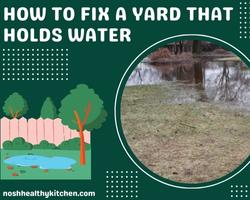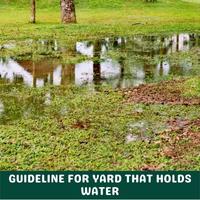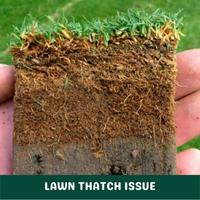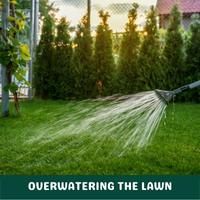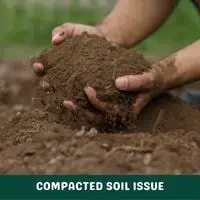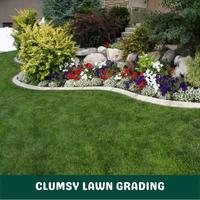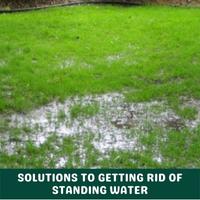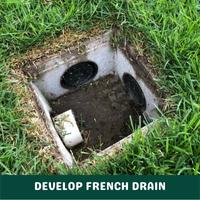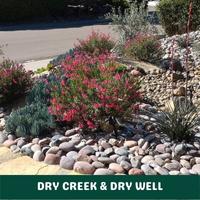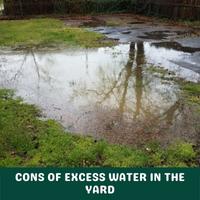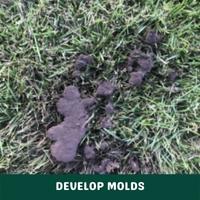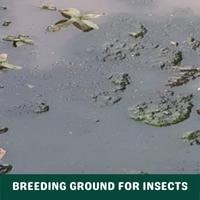How to fix a yard that holds water. A yard is the most peaceful place to make your morning and evening delightful. No doubt it’s a source of inhaling fresh air and feeling a cool breeze.
But nobody wants to destroy the beauty of the yard with standing water. It must be hard for you to see your yard giving the vibes like a pond.
Standing water does not just look like a puddle but also has some cons, like damage to the home’s foundation, causing mold, and may lead to the reproduction of flies and mosquitoes.
So, it would be better to resolve the issue of stagnant water due to different reasons as soon as you want to avoid any further issues.
In this post, we will discuss how to fix a yard that holds water and the reasons for standing water. Let’s start going through the way without wasting your time.
How to fix a yard that holds water
Guideline For Yard That Holds Water
If you are experiencing the issue of water pooling in your lawn or yard, there must be some reasons behind it.
You can get rid of standing water and follow the tips and factors to prevent it from occurring again.
In this article, you may get to know about the reasons, fixes, and cons of standing water thoroughly. So, let’s get started.
Reasons For Collect Water In Yard
In this section of the article, we’ll explain the reasons that may cause standing water in your yard. That may help you to improve the drainage system as well as able you to gid rid of the collecting excess water.
Lawn Thatch Issue
The first thing that might be the reason for water pooling on your lawn is that thatching.
If you suspect that your lawn or water pooling surface is not absorbing water, it might be possible that you have a thatching issue.
The grass clippings, leaf litter, or dead plants build up a layer of blockage in the way of grass and soil. Then the soil fails to absorb water, resulting in standing water in your yard.
OverWatering The Lawn
Another common issue of excessive water in your yard is watering the lawn daily without inspecting it, whether absorbing or taking the shape of a pool.
It mostly happens when you have an irrigation system or an automatic sprinkler system used to do water at your place.
So, sometimes inappropriate watering schedule leads to poorly draining soil and become the culprit for water standing on the surface.
To resolve the issue, we suggest you adjust your watering schedule and prevent overwatering by giving less water or avoiding watering regularly.
Compacted Soil Issue
Soft soil type has more capacity to seep water and reduce the chances of gathering excess water. So you can say that the soil type also affects the absorption ability.
So the sticky clay soils or hard soil types can’t absorb water efficiently, that cause standing water on the lawn.
Especially hardpan soil, like thick soil coating on the surface, creates complexities in seeping water for the soil and results in a stagnant water issue.
Clumsy Lawn Grading
Poor drainage is another reason that may cause stagnant water in your yard. If you have not paid attention to the yard grading, it may be hard to absorb water from the surrounding soil.
Lawn grading or leveling enables the water runoff to the storm drain and prevents excess water. On the other hand, improper grading of landscaping slop tends to improper drainage.
You may also blame clumsy grading for poor drainage and acquiring water in the low spots of your yard, and it gets underground.
Water Table Reason
Another reason for pooling water is the water table, which collects water absorbed by the surface and switches into groundwater.
A water table is a soaked subsurface at the bottom that includes rock and belowground soil. And the heavy rain causes a flooded surface and results in standing water.
If you find lawn care hard to tackle, you may create raised beds in case of a high water table. That has more possibilities to grow well in pooling water.
Solutions To Getting Rid of Standing Water
After knowing the reasons, you may get the idea that why you are facing the accumulated water on your lawn. Now, it would be better to fix a yard by following the solutions mentioned below.
Dethatching Your Lawn
If you inspect that the thatching is a reason for standing water on your lawn, then you must need to resolve the issue by dethatching it.
Doing dethatching your lawn help you to gain the absorption ability back. So, to accomplish this task, you may use a dethatcher or a lawn rake to remove dead plant debris.
It would be best to apply a layer of mulch or add compost to maintain moisture in the soil and reduce the possibility of thatching after dethatching.
Aerate the Lawn
After dethatching your lawn, it would be better to make holes in the soil. You require a simple lawn aerator to do the task better.
It will help you split up the compacted soil and allow the water and air to get through the grassroots. That increases the efficiency of grass growing.
It would help to place small holes at least four to five inches deep with a space of two to three inches to get proper results. You may also use organic matter for seeping efficiently.
Lawn Grading or Leveling
As we already discussed, leveling or grading in your yard is essential and affects standing water.
To resolve this issue, you must ensure that the slope or land is high to low from the home’s foundation to the storm drain.
You may contact a professional contractor to do the task of inspecting low spots and drainage outlets to ensure better water drainage.
Develop French Drain
If you have improper yard drainage due to low spots or clumsy grading, you may resolve the standing water issue by developing a drainage system.
You may channel water by developing french drains close to a storm drain and can divert the water underground. You may also use perforated pipes to run off diverted to the sewers.
Re-grading patios or footwalks is much more costly to solve the standing water issue. In that case, a buried french drain must be a great idea to get rid of standing water.
So, you must dig a gravel-filled trench and ensure the end of the trench tends to the low slope so that the water can flow freely towards the storm sewer with gravity. Install a perforated pipe and examine the draining.
Dry Creek & Dry Well
Building a dry creek is a valuable way to prevent your yard that holding water. If you are not comfortable with a french drain, then a dry creek is a better way to improve drainage.
So, a dry creek is a way of rocks or stones that channel water toward the storm drain. You may also divert runoff to the dry well.
A dry well is a deep hole filled with rocks. When it’s raining, the water flows tend to dry well through the dry creek and absorb in the soil.
So, it depends on you whether you want to build a dry creek to the dry well or you want to water drainage into the storm drain.
Make A Rain Garden
Another solution for preventing water is creating a rain garden. Rain gardens are built at the lowest spot or slop of a yard. It resolves the drainage issues by runoff water to the rain garden.
It is a great idea to prevent pooling water using natural items. You may select flower plants with fibrous roots and shrubs that are well suited to water.
So, building a rain garden is a cost-friendly method to seep water and save your yard from standing water. It will also add attraction while alluring honey bees and butterflies.
Cons Of Excess Water In The Yard
So, it would be better to educate yourself on how much standing water in your yard may be dangerous for you to take action immediately to prevent any health risks and your or your neighbor’s property damage.
Here is a list of issues created by standing water.
Harmful To Home’s Foundation
One of the most significant losses you may face due to water pooling is damaging the foundation of your house.
Whenever you suspect rain seeps near the foundation around your house, you take action to fix the issue.
It may cause wearing out the foundation, resulting in moving back or out and laying pressure on the bottom. With time you may face an insecure foundation that may cost more than fixing the standing water issues.
Develop Molds
Holding water near the foundation doesn’t only lead to wear out the foundation but can create mold and start growing on the walls.
Mold is not only caused to pollute the surface, ruining the attraction and developing health risks.
Fungal Disease
Standing water or squashy yard determines fungal diseases and bald spots. It includes a fairy ring, a dollar spot, and red thread.
The situation is hard to tackle and ends up with a significant loss. You must fix the drainage problems before it turns into a severe situation.
Breeding Ground For Insects
Stagnant water is the most suitable breeding ground for different insects like mosquitoes. Mosquitoes are fond of laying eggs on the water and turn in multiple within a few days.
It is not just a matter of breeding, but it may lead to different diseases like the west Nile virus, dengue, malaria, etc. So, you have you fix a yard that holds water as soon as possible.
Allure Vermin
Vermins are pests that are standing water lovers. Like rats or mice, these species love to make nests and water holes in stagnant water.
Alluring vermin not only spread disease to human beings but are also harmful to pets.
Algae & Bacteria
Another risk you are taking with standing water is bacteria and algae growth. No doubt that bacteria are harmful to humans and other animals.
As well as, the algae on the water surface develop germs and infections.
Conclusion
We hope that you may get the proper assistance on how to fix a yard that holds water. You may follow the instructions to fix the issue and know the reasons that may lead to standing water in your yard.
You can fix the issue by building a french drain, dry well, dry creek, dethatching, and much more. You may also get to know about the cons of pooling water.
If you find it a hard job to re-grad or fix, you may contact a landscaping company to work for you.
Related Guides
